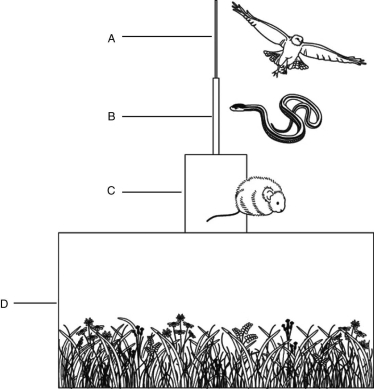Correct Answer

verified
Correct Answer
verified
Multiple Choice
Which one of the following is TRUE regarding an ecological pyramid?
A) An ecological pyramid can depict either the total amount of energy stored at each level of an ecosystem or the total biomass at each level.
B) The population of producers depends largely on the populations of consumers below it.
C) The amount of energy represented by tertiary consumers is greater than the amount of energy represented by primary consumers.
D) Animals such as wolves and eagles would be located at the base of the pyramid.
E) The amount of energy represented by producers is equivalent to the amount of energy represented by the secondary consumers.
G) A) and E)
Correct Answer

verified
Correct Answer
verified
True/False
A species moving into a new habitat will be able to adapt only if there is genetic change in the population.
B) False
Correct Answer

verified
Correct Answer
verified
Multiple Choice
Herbivores may also be referred to as
A) producers.
B) quaternary consumers.
C) primary consumers.
D) carbohydrate consumers.
E) autotrophs.
G) C) and D)
Correct Answer

verified
Correct Answer
verified
Multiple Choice
Regular, consistent intervention, such as some modern logging practices, may create which type of stable community?
A) immature
B) evergreen
C) forest
D) recovered
E) varied
G) B) and D)
Correct Answer

verified
Correct Answer
verified
Multiple Choice
Under natural conditions, the amount of nitrogen gas returned to the atmosphere by denitrification approximately equals
A) phosphorus cycling.
B) evaporation.
C) nitrogen fixation.
D) sublimation.
E) photosynthesis.
G) A) and C)
Correct Answer

verified
Correct Answer
verified
Multiple Choice
Trees undergoing photosynthesis in a mature forest can best be described as
A) primary consumers.
B) secondary consumers.
C) chemoautotrophs.
D) primary producers.
E) heterotrophs.
G) C) and E)
Correct Answer

verified
D
Correct Answer
verified
Multiple Choice
Which statement describes the expected population growth in the next 50 years?
A) The population growth will be relatively equal throughout the world.
B) The greatest population growth is likely to occur in the more industrialized countries, including the United States and Europe.
C) Most countries worldwide will achieve zero population growth in the next 10 years.
D) The greatest population growth is likely to occur in the least industrialized countries.
E) There will be a net decline of population, with the United States and other industrialized countries contributing most to the population decline.
G) B) and C)
Correct Answer

verified
Correct Answer
verified
True/False
The introduction of invasive species may increase the environmental resistance for a native species.
B) False
Correct Answer

verified
Correct Answer
verified
Multiple Choice
Match each term to its definition. -area in which the species is distributed
A) habitat
B) ecosystem
C) geographic range
D) niche
E) community
G) B) and D)
Correct Answer

verified
Correct Answer
verified
Multiple Choice
Match the following. -a plant producing high-energy carbohydrates from carbon dioxide and water, using energy from the sun
A) herbivore
B) decomposer, carnivore
C) omnivore
D) producer
F) All of the above
Correct Answer

verified
Correct Answer
verified
Multiple Choice
Match the following. -a blow fly feeding on a corpse
A) herbivore
B) decomposer, carnivore
C) omnivore
D) producer
F) C) and D)
Correct Answer

verified
B
Correct Answer
verified
Multiple Choice
During photosynthesis, high-energy carbohydrates are produced at the end of
A) light absorption by chlorophyll.
B) cellular respiration.
C) the light reactions.
D) the Calvin cycle.
E) the electron transport pathway.
G) A) and C)
Correct Answer

verified
Correct Answer
verified
Multiple Choice
A species' biotic potential is intrinsically determined by all of the following EXCEPT which one?
A) the number of members of reproductive age
B) the number of offspring produced by each reproducing member
C) the time span before offspring reach reproductive maturity
D) the ratio of males to females
E) the presence of competing species in the same habitat
G) C) and D)
Correct Answer

verified
Correct Answer
verified
Multiple Choice
 The figure above shows an ecological pyramid. Which level of this pyramid contains the primary producers?
The figure above shows an ecological pyramid. Which level of this pyramid contains the primary producers?
A) A
B) B
C) C
D) D
E) C and D
G) B) and C)
Correct Answer

verified
Correct Answer
verified
True/False
Mature communities generally exhibit the greatest species diversity.
B) False
Correct Answer

verified
True
Correct Answer
verified
Multiple Choice
If the population age structure of a country resembles a pyramid, with the pre-reproductive age group the largest proportion of the population, and the post-reproductive age group the smallest, this country can most likely be classified as one of the
A) stable populations.
B) least developed countries.
C) most developed countries.
D) steady-state populations.
E) expanding populations.
G) A) and B)
Correct Answer

verified
Correct Answer
verified
Multiple Choice
Match the following. -a cow feeding on grass in a field
A) herbivore
B) decomposer, carnivore
C) omnivore
D) producer
F) A) and D)
Correct Answer

verified
Correct Answer
verified
Multiple Choice
The process of converting nitrogen gas to ammonium is called
A) biogeochemical processing.
B) sublimation.
C) nitrogen fixation.
D) evaporation.
E) nitrification.
G) A) and E)
Correct Answer

verified
Correct Answer
verified
Short Answer
The number of offspring produced by each reproducing member of a species, the ratio of males to females, and the time it takes offspring to become reproductively mature are determinants of the ________ of a population.
Correct Answer

verified
Correct Answer
verified
Showing 1 - 20 of 85
Related Exams